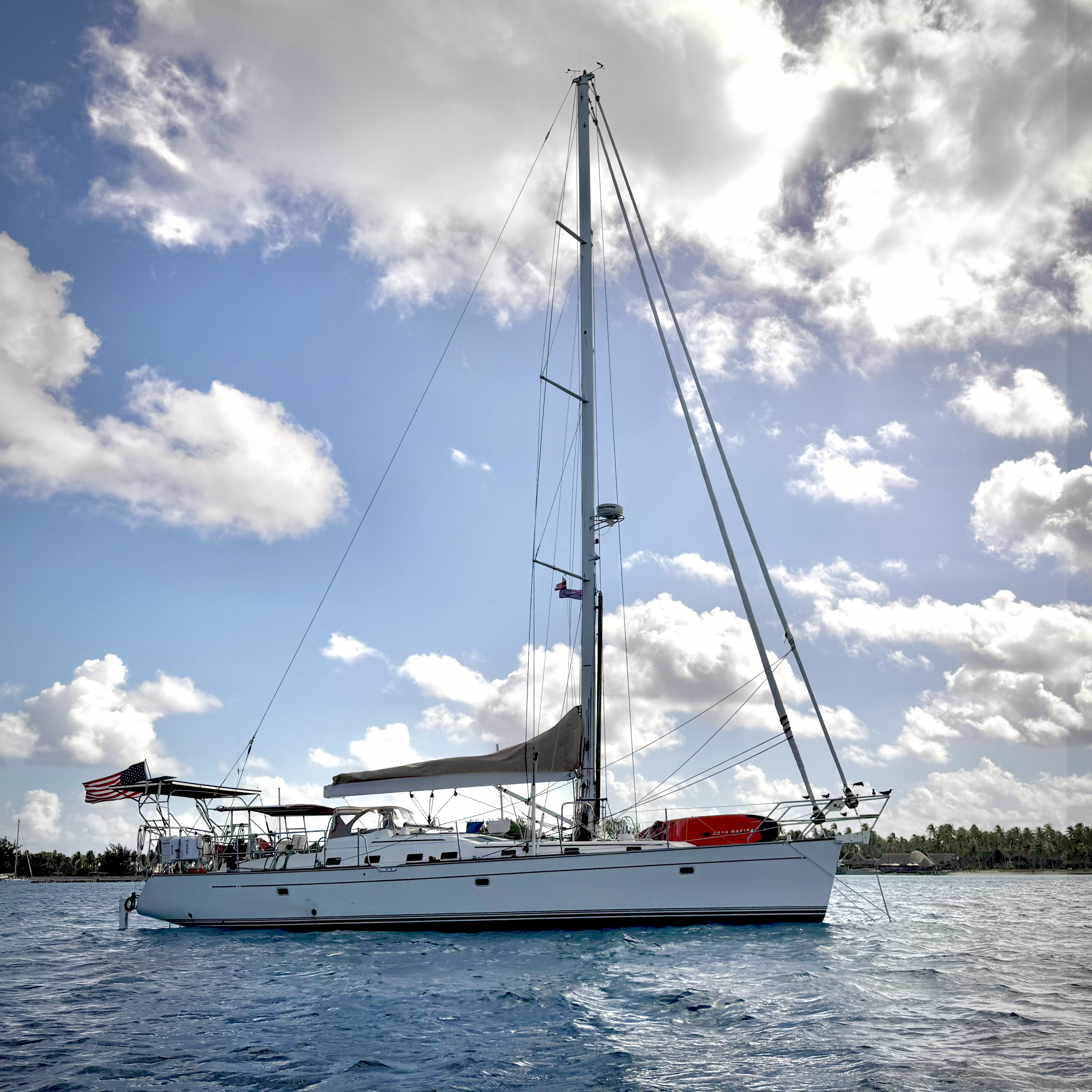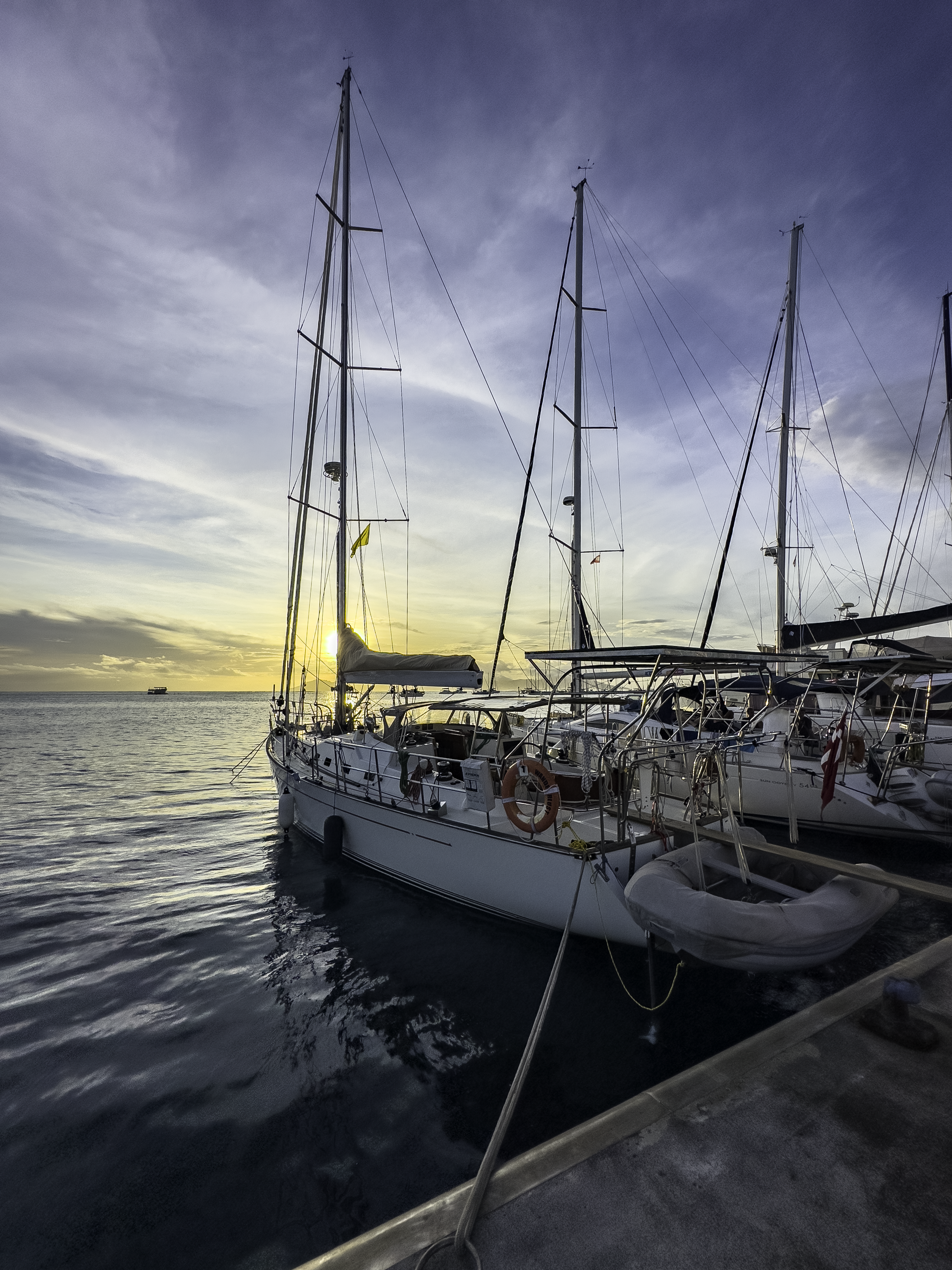The “Rolly Anchorage”
There’s a certain irony in calling this a ‘rolly anchorage,’ because while some would see only discomfort, we find it alive with its own rhythm.
Tonight, Jane and I are sitting in the cockpit as the sun goes down over the Rangiroa lagoon in the Tuamotus of French Polynesia. The new moon has brought bigger tides as well as darker nights, and a shift in the wind has Wanderlust dancing more than usual. Some would complain — too much motion, not enough shelter. But we find ourselves smiling. The horizon is ours, the air is clean, and the gentle sway feels more alive than the stillness of a dock.
Here, the lagoon has its own rhythm. Almost every morning and evening it erupts into what I can only describe as a feeding frenzy. Schools of fish churn the water, each size preying on the next, while brown noddies and other birds dive and swarm overhead. It’s chaotic, beautiful, and unscripted — the kind of theater only nature provides.
And when it ends, the stage clears to quiet. No dock lights, no neon, no bar chatter or loud music. Just us, the anchorage, and a sky wide enough to feel infinite. At anchor, you can slip into the water and know it’s clean or sit back and watch the horizon swallow the sun with nothing between you and the night.
The Seamanship of Anchoring
Anchoring isn’t just stopping the boat. It’s a small act of seamanship and trust every time. You look at the chart, read the bottom, gauge the swing room, and decide how much scope you need.
For life on the hook, the quality of ground tackle can’t be stressed enough. On Wanderlust, we carry 100 meters of 10mm chain backed by 100 meters of 17mm nylon rode. Our anchor is a stainless-steel, 45kg (99lb) spade style Ultra Anchor connected to the chain with an ultra-strong stainless-steel swivel. Overkill for many situations but sized for when conditions are less than ideal.
Once the anchor is down, we back down to set it firmly running the main diesel up to 1800-2000 rpm. If the water is clear — and in these lagoons it usually is — I’ll sometimes swim out to check it, making sure the anchor is buried, and the chain isn’t draped across coral. In the Tuamotus, we typically float the anchor chain with large fenders to minimize problems with coral.

Then comes the quiet responsibility of keeping watch. Even when you relax into life at anchor, part of your awareness is tuned to the weather, the tides, the feel of the boat’s motion. If the wind shifts in the night, one of us will poke a head out of the hatch, check bearings against the shore, and make sure the anchor is still holding. That vigilance isn’t a burden; it’s part of the rhythm. There’s a deep satisfaction in knowing the boat is secure because you made it secure.
Some nights test that trust. I remember one blow in Long Island Sound when the wind howled for hours hitting almost 50 knots and the fetch built into steep waves across the anchorage. We sat in the salon, listening to the chain groan and the snubber stretch, but we held. The anchor did its job, and so did we. In the morning, we were still right where we had dropped the hook, and the feeling of relief blended with pride. That’s the kind of experience a marina can’t replicate.
Tied to the Dock
Marinas, of course, have their place. They make it easier to get fuel and water, to haul groceries back without juggling dinghies and dry bags, to have parts delivered for boat work. There’s a social energy too: neighbors close by, willing hands to catch lines, the occasional dock party. For some cruisers, that community is part of the appeal.
For us, the reasons we go to a marina are more specific. After a long ocean passage, we’ll often take Wanderlust into a dock for one very practical purpose: to clean her thoroughly with unlimited water. Salt gets into every crevice on a passage, and nothing feels better than giving the decks, rigging, and even the sails a proper rinse. It’s less about convenience and more about care — making sure the boat that carried us safely across hundreds or thousands of miles is looked after.

The other time we tie up is when life ashore calls us back. About once a year we fly to the United States to take care of family or business, and when we do, we want Wanderlust as secure as possible. In those moments, the marina is peace of mind: strong dock lines, attentive staff, and the ability to step off the boat with our bags.
Of course, marinas also come with a price tag. In many parts of the world, daily rates rival the cost of a hotel room, and monthly contracts can be the single biggest expense in a cruiser’s budget. By contrast, most anchorages are free, except in a handful of crowded harbors where a small fee is charged. The sea itself doesn’t send a bill, which is part of the appeal.
Beyond those specific reasons, marinas rarely draw us in. We don’t need shore power; our systems run quietly and efficiently on solar and modern batteries. We don’t depend on marina Wi-Fi; Starlink gives us connectivity wherever we drop the hook. And while walking off the boat onto a dock is easy, there’s something about taking the dinghy that makes each trip ashore feel like a small adventure. That little separation between boat and land is part of the cruising life we chose.
At the dock, even in clean marinas, the water is usually not something you want to swim in. The view is often another row of masts or a line of pilings. Nights are lit by dock lights instead of stars. A marina stay feels to us like a pause — sometimes necessary, sometimes welcome — but never the reason we sail.
The Philosophy Beneath the Choice
Where you keep your boat says something about how you see the cruising life. For some, marinas are a tether: security, predictability, and a taste of shore life without giving up the boat. For others, the anchor represents independence: the willingness to trade convenience for self-reliance, and comfort for connection to the sea.
Over the years, we’ve noticed how cruisers sort themselves out. Newer sailors often favor marinas at first, learning systems and routines in a setting that feels safer. Over time, many begin to prefer anchorages, discovering the confidence that comes from setting the hook and swinging free. Those who remain drawn to docks often speak of ease — no dinghy rides, fewer unknowns, less worry. Those who drift toward anchoring talk about freedom — the horizon always close, nature always present.
Dropping anchor also keeps you more attuned to natural rhythms. You feel the wind shift, hear the rustle of palms ashore, notice the daily patterns of fish and birds. Time stretches differently: mornings linger over coffee, afternoons drift into swims or small boat projects, evenings ease into quiet without neon distractions. Cruising at anchor teaches patience, awareness, and a kind of intimacy with the world outside the hull.
For us, the anchor is more than ground tackle; it’s a philosophy. To swing free at the end of the day, horizon unbroken, stars overhead, and water clean enough to dive into — that’s the life we signed up for.
Between Dock and Horizon
Every cruiser finds their own balance, and there’s no right or wrong. Some thrive on the bustle of marina life, others on the solitude of remote anchorages. Most of us shift back and forth as needs and moods change. But where you spend most of your time says a lot about what you value in this life afloat.
Here in Rangiroa, the choice feels clear. As the boat rocks gently to the southern swell and the last colors of sunset fade into the dark of a new moon night, we know we’re where we want to be. Tomorrow the lagoon will again boil with fish and noddies in their feeding frenzy, and we’ll watch with coffee in hand.
We’ll step off the stern into water clear enough to see the bottom twenty meters down. And when the night comes, there will be no dock lights, no background noise, no interruptions — only the quiet breath of the boat and a sky so vast it makes time itself feel wider.
That’s why, for us, the hook always wins. Not because marinas are bad, or anchoring is noble, but because swinging free reminds us of the life we chose: simple, self-reliant, open to the sea’s rhythms. In the end, being at anchor isn’t just where we keep the boat. It’s where we keep ourselves.
